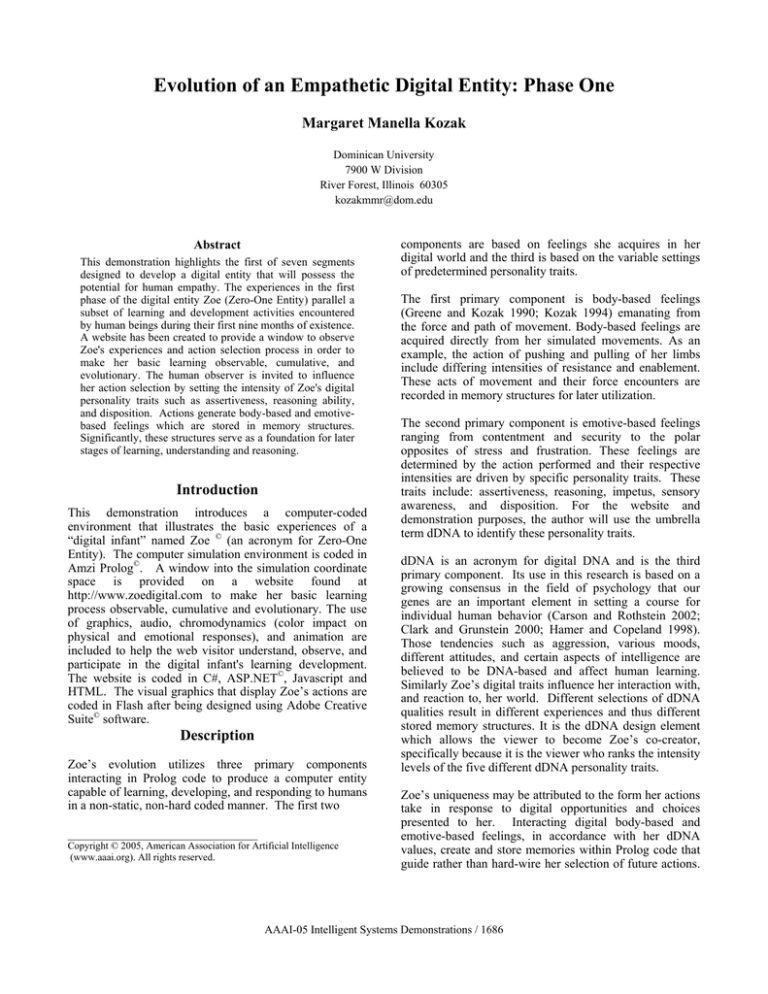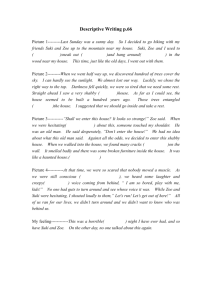
Evolution of an Empathetic Digital Entity: Phase One
Margaret Manella Kozak
Dominican University
7900 W Division
River Forest, Illinois 60305
kozakmmr@dom.edu
Abstract
This demonstration highlights the first of seven segments
designed to develop a digital entity that will possess the
potential for human empathy. The experiences in the first
phase of the digital entity Zoe (Zero-One Entity) parallel a
subset of learning and development activities encountered
by human beings during their first nine months of existence.
A website has been created to provide a window to observe
Zoe's experiences and action selection process in order to
make her basic learning observable, cumulative, and
evolutionary. The human observer is invited to influence
her action selection by setting the intensity of Zoe's digital
personality traits such as assertiveness, reasoning ability,
and disposition. Actions generate body-based and emotivebased feelings which are stored in memory structures.
Significantly, these structures serve as a foundation for later
stages of learning, understanding and reasoning.
Introduction
This demonstration introduces a computer-coded
environment that illustrates the basic experiences of a
“digital infant” named Zoe © (an acronym for Zero-One
Entity). The computer simulation environment is coded in
Amzi Prolog©. A window into the simulation coordinate
space is provided on a website found at
http://www.zoedigital.com to make her basic learning
process observable, cumulative and evolutionary. The use
of graphics, audio, chromodynamics (color impact on
physical and emotional responses), and animation are
included to help the web visitor understand, observe, and
participate in the digital infant's learning development.
The website is coded in C#, ASP.NET©, Javascript and
HTML. The visual graphics that display Zoe’s actions are
coded in Flash after being designed using Adobe Creative
Suite© software.
Description
Zoe’s evolution utilizes three primary components
interacting in Prolog code to produce a computer entity
capable of learning, developing, and responding to humans
in a non-static, non-hard coded manner. The first two
______________________________
Copyright © 2005, American Association for Artificial Intelligence
(www.aaai.org). All rights reserved.
components are based on feelings she acquires in her
digital world and the third is based on the variable settings
of predetermined personality traits.
The first primary component is body-based feelings
(Greene and Kozak 1990; Kozak 1994) emanating from
the force and path of movement. Body-based feelings are
acquired directly from her simulated movements. As an
example, the action of pushing and pulling of her limbs
include differing intensities of resistance and enablement.
These acts of movement and their force encounters are
recorded in memory structures for later utilization.
The second primary component is emotive-based feelings
ranging from contentment and security to the polar
opposites of stress and frustration. These feelings are
determined by the action performed and their respective
intensities are driven by specific personality traits. These
traits include: assertiveness, reasoning, impetus, sensory
awareness, and disposition. For the website and
demonstration purposes, the author will use the umbrella
term dDNA to identify these personality traits.
dDNA is an acronym for digital DNA and is the third
primary component. Its use in this research is based on a
growing consensus in the field of psychology that our
genes are an important element in setting a course for
individual human behavior (Carson and Rothstein 2002;
Clark and Grunstein 2000; Hamer and Copeland 1998).
Those tendencies such as aggression, various moods,
different attitudes, and certain aspects of intelligence are
believed to be DNA-based and affect human learning.
Similarly Zoe’s digital traits influence her interaction with,
and reaction to, her world. Different selections of dDNA
qualities result in different experiences and thus different
stored memory structures. It is the dDNA design element
which allows the viewer to become Zoe’s co-creator,
specifically because it is the viewer who ranks the intensity
levels of the five different dDNA personality traits.
Zoe’s uniqueness may be attributed to the form her actions
take in response to digital opportunities and choices
presented to her. Interacting digital body-based and
emotive-based feelings, in accordance with her dDNA
values, create and store memories within Prolog code that
guide rather than hard-wire her selection of future actions.
AAAI-05 Intelligent Systems Demonstrations / 1686
Candidate actions are placed on a blackboard structure
where present feelings vote approvals for appropriate
actions. But the voting process is not predetermined, not
straightforward, nor is it static, nor is it totally random. It
is, however, predictable and random enough to parallel the
behavior one might expect of a human with similar DNA
traits.
and crying, Zoe may never attempt to sit up. Unlike the
more aggressive Zoe in the first example, if the lethargic
Zoe tries and fails she will almost never try again. Thus,
feelings of intense discomfort, stress and crying will vote
for very different actions than will the feelings of intense
frustration and boredom discussed in the previous
example.
The underlying technology that drives this process is
described in significant detail in a forthcoming article
submission for journal review. However, two examples
from a number of possible combinations are provided
below to illuminate how the dDNA influences Zoe’s
behavior.
Conclusion
The first example assumes the web participant set Zoe’s
dDNA personality traits as follows: a high degree of
aggression, a strong drive, an above average reasoning
ability plus sensory awareness, and an average disposition.
Such dDNA settings insure that Zoe will eventually exert
the effort required to accomplish a number of different
body-based tasks such as sitting up, stretching her arms,
and focusing even though it may take her several attempts.
The repeated attempts reflect the aggressive, driven nature
that will tolerate a relatively high pain threshold due to
Zoe’s dDNA settings. This aggressive, driven nature in
turn gives rise to emotive-based feelings of increasing
frustration each time Zoe fails at an attempted action. As
her frustration level increases so will her desire to
successfully perform this action. Since the dDNA settings
also reflect a high degree of reasoning ability, emotivebased feelings of boredom and curiosity increase as novel
experiences decrease. To decide and select her next
response within the Prolog code, possible candidate
actions are listed on a blackboard type structure and her
feelings contribute approval votes to appropriate actions.
Feelings of boredom and curiosity will vote approval for
actions not recently nor successfully executed. As a further
example the feeling of frustration will vote approval for
those actions where recent attempts at execution have
failed. The quantity of votes contributed by a feeling is
proportional to the respective intensity of the feeling.
The second example assumes the web observer selected
dDNA characteristics that reflect a very lethargic and
passive entity with a low pain threshold. Such dDNA
settings would promote very different emotive-based
feelings relative to the first example delineated above.
These emotive-based feelings would include intense
discomfort, internal stress and a strong propensity to cry. If
her reasoning ability trait was low, then her emotive-based
feelings of curiosity and boredom would also remain
relatively low. She would not effectively seek novel action
as she did in the previous example. Due to her high degree
of lethargy and passivity, she would not exert significant
effort. Furthermore, her low threshold for pain will cause
her to cry most of the time, distracting her from alternate
action. In fact, with these dDNA settings and resulting
prevalence of emotive-based feelings of stress, discomfort,
This demonstration highlights the first of seven segments
in Zoe’s growth and development. It is entitled “Infant”
and is the digital equivalent to the first nine months of
human development (Berk 2000). Which actions Zoe
performs and in what sequence depends largely upon the
dDNA settings initialized by the demonstration observer.
While the actual actions performed are predictable for a
particular combination of dDNA values, they are not
predetermined and in fact do vary slightly for different
simulation runs of the same combination, which is
characteristic behavior of a human being as well. Explicit
details regarding this demonstration and explanation of
additional aspects have been prepared in an article to be
submitted soon for journal review.
References
Berk, L. 2000. Child Development, Fifth Ed. Boston, MA.:
Allyn and Bacon.
Brave, S., and Nass, C. 2003. Emotion in Human-Computer
Interaction. Chapter 4 in The Human-Computer Interaction
Handbook: Fundamentals, Evolving Technologies and Emerging
Applications, ed. J. Jacko and A. Sears. Mahwah, N.J.:
Lawrence Erlbaum Associates.
Carson, R. and Rothstein, M. eds. 2002. Behavioral Genetics:
The Clash of Culture and Biology. Baltimore, MD.: Johns
Hopkins University Press.
Clark, W. and Grunstein, M. 2000. Are We Hard-Wired?: The
Role of Genes in Human Behavior. Oxford: Oxford University
Press.
Greene, P., and Kozak, M. 1990. A Body-Based Model of the
World. In Proc. of the Fifth IEEE International Symposium on
Intelligent Control, 81-85.
Hamer, D., and Copeland, P. 1998. Living with Our Genes.
New York, N.Y.: Doubleday.
Kozak, M. 1994. Body-Based Cognition. Ph.D. diss., Dept. of
Computer Science, Illinois Institute of Technology.
Picard, Rosalind. 1997. Affective Computing. Cambridge, MA.:
The MIT Press.
AAAI-05 Intelligent Systems Demonstrations / 1687






